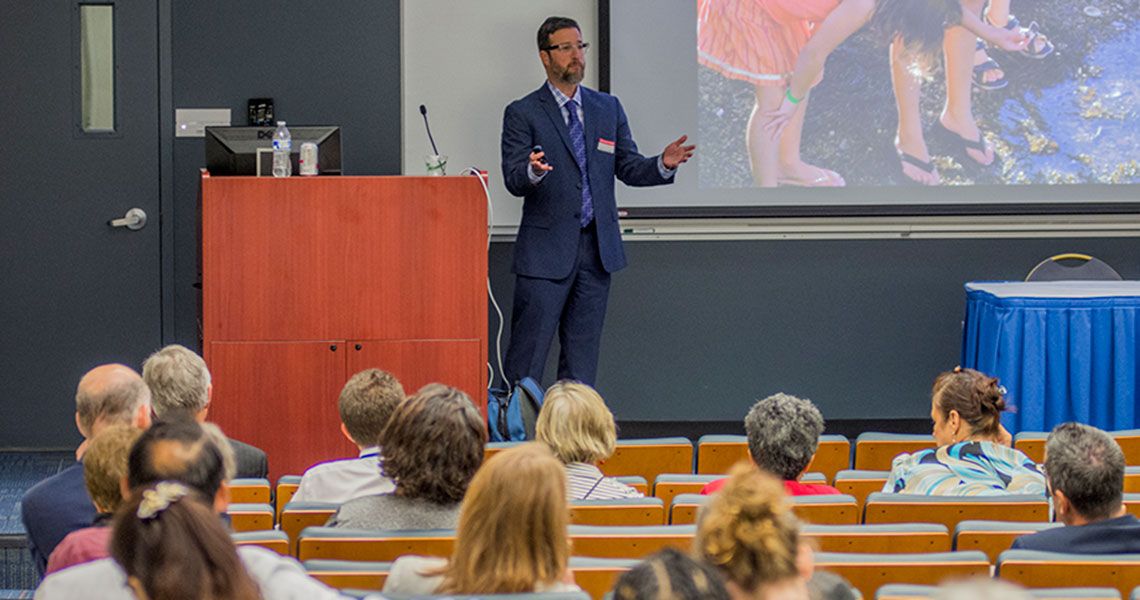“Marly was — is — one of the most special people you’ll ever meet,” says Jack Watson, his face filling the screen in Ross Hall 117 at the George Washington University School of Medicine and Health Sciences (SMHS). The camera pans to cheerful Christmas ornaments, school portraits, and candid snapshots of Jack’s smiling daughter, Marly, a Shania Twain fan with a penchant for wire-rimmed glasses and colorful hats. Jack and his wife, Dana, believed Marly had obsessive-compulsive disorder, which manifested in her tween years. Visits to the doctor, however, quickly changed that diagnosis.
“We felt this was most likely a low-grade tumor called ‘pilocytic astrocytoma,’ which is actually the most common type of brain tumor in a child,” explains Melanie Comito, M.D., a pediatric oncologist at Penn State Hershey Cancer Institute, to the camera. Months after receiving radiation treatment, Marly worsened, and she was diagnosed with radiation necrosis. “It’s a relatively rare complication, but when it happens, it’s devastating,” Comito adds.
Now a 14-year-old, Marly is bedridden, though Dana and Jack support her in every way they can, including, as Jack terms it, “bringing home the bacon” to pay for her medical bills, and driving her to hyperbaric oxygen therapy treatments hours from home. “The worst part of the deal,” Jack says, pausing to choke back emotion, “was when they told us Marly wasn’t going to get better.”
The film, “Marly Watson,” was one of several created by Penn State Medical School students, explained the inaugural Medical Education Grand Rounds speaker Dan Shapiro, Ph.D., vice dean for faculty affairs and professor and chair of humanities at the school. The new series is supported by Yolanda Oertel, M.D., RESD ’72, and James Oertel, M.D.
“I’m delighted that Dr. Shapiro could be here with us to be our inaugural Medical Education Grand Rounds speaker,” said Richard Simons, M.D., senior associate dean for M.D. programs at SMHS, before Shapiro took the stage.
As Shapiro explained to the students, residents, and faculty on hand, the theory behind the videos, which takes students away from the hospital and into the homes of their patients, is designed to fill the gap in what he says is a significant weakness in medical education.
“The way we’ve structured medical education, which is partially a product of our history, leads us to make some critical mistakes,” he said. As medicine has evolved, with movements in public health and antibiotics, among others, treatment has shifted away from home visits and extended in-patient sessions. Physicians no longer emphasize healing the “whole person,” Shapiro says, and those coping with chronic illnesses receive less attention.
“We’re doing drive-thru medicine now,” he said. “We are discharging patients that just 15 years ago we would’ve admitted because they were so sick.”
Some of Shapiro’s views come from his own personal history; in his early twenties, he was diagnosed with Hodgkin’s lymphoma. He received a bone marrow transplant and relapsed twice, but he has been cancer-free for the last two decades. Because of his early entrée into medicine, Shapiro understands treatment from the patient perspective. Help from an “aha” moment also pushed him to promote his unique program.
“I saw things I had not seen when [filming] was live,” Shapiro said, as he explained his experience editing a family video and playing the same few seconds repeatedly. “It occurred to me that if we had medical students doing this about patients, they would get to know the patient experience in a way that wouldn’t happen, and they might be stoked to do it.”
Shapiro purchased equipment — prosumer cameras, audio equipment, and tripods — and earned a grant to help with funding. A former film major at Vassar College, he then instructed his students on basic film techniques and audio recording.
“I told them to follow their curiosity,” he said, “and film everything: film the slippers, the barking dog, what [the patients] keep in the refrigerator, where do they keep their medications, how do they track [taking their medicine].”
The students got eight months to film their consenting patient. “They’ve got to do at least one clinic visit,” Shapiro said, “they have to capture how a patient adheres or struggles to adhere to a medical regimen, and they have to capture how a patient lives with or struggles to live with their illness. They also have to capture patients’ innovative adaptations to illness — what a patient does that uniquely responds to the challenge.”
The resulting films, which are screened during a video slam — though Shapiro refers to it as a “sniffle fest” — reveal stark information about the subjects. Suffering from a range of diseases, including cancer, AIDS, cystic fibrosis, diabetes, and chronic illnesses, the patients speak about living with their diseases and their various coping mechanisms. One caregiver, a daughter whose father has ALS, uses a unique sliding board to move him from bed to wheelchair. Another patient displayed her extensive pill box, which she uses to organize her array of daily medications.
For the students, the films are invaluable. They learn to create non-linear narratives, Shapiro said, and the videos tend to expose students’ depth of attention and listening skills when speaking with their patients. Video making and editing also allow students to become more observant of their patients’ environments, and it’s a project that they frequently cite in resident interviews.
As a whole, the videos are a small movement toward more patient-centered care. “We rely a lot on physician educators, but until we rely more on patient narratives — and there are so many different ways to get this information, this is just one of them — I don’t think we’ll end up doing everything we can,” Shapiro said.
Shapiro’s presentation is just one of many scheduled this year for the Medical Education Grand Rounds series. Lectures on contemporary medical education topics will occur on a quarterly basis, and faculty, students, and staff are welcome to attend.



